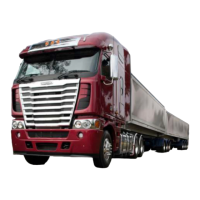To enhance engine braking, downshifts are per-
formed at higher rpm than normal.
If L is selected from neutral while stopped, the ve-
hicle starts in first gear and stays there until the en-
gine approaches overspeed.
Upshifting
To request an upshift with the transmission in drive,
pull the control lever up (towards the driver). If the
gear is available, the transmission will upshift and the
new gear will display on the gear indicator. Skip
shifts are not available while upshifting. Upshifts are
not available in low, except to prevent engine over-
speed.
If the transmission does not upshift quickly enough
after engine start up or a load change, begin the shift
manually. The TCU will learn the new load-based
shift conditions after three or four shifts.
If the gear requested is unavailable, a tone will
sound. An unavailable request to upshift is not stored
in memory; the upshift must be requested again.
Downshifting
To request a downshift with the transmission in drive
or low, push the control lever down (away from the
driver). If the gear is available, the transmission will
downshift and the new gear will display on the gear
indicator. Skip shifts are available while downshifting.
For best engine braking, select low while moving. In
low, downshifts are performed at higher rpm than in
drive.
IMPORTANT: If the engine is approaching over-
speed, the TCU will override the current gear
setting and upshift to prevent engine damage.
If the gear requested is unavailable, a tone will
sound. An unavailable request to downshift is not
stored in memory; the downshift must be requested
again.
When coasting to a stop, the TCU may not finish the
downshift until the driver depresses the accelerator
pedal again.
IMPORTANT: A downshift request can never
result in a shift into neutral, even if the vehicle is
in the drive position in the lowest possible gear.
Before starting down a hill, slow down. Downshift to
a speed that you can control without hard pressure
on the service brakes.
Before entering a curve, slow down to a safe speed.
Downshift if necessary. This lets you use some
power through the curve to help the vehicle be more
stable on the turn. It also allows you to regain speed
faster as you come out of the curve.
Shutdown
1.
Apply the service brakes.
2.
Move the gear selector switch to the N position.
When the N on the gear indicator is solid (not
flashing), the TCU is ready to shut down.
3.
Set the parking brake.
4.
Turn off the ignition key and shut down the
engine.
Ultrashift Diagnostics
Clutch Protection Fault
Even though a vehicle with an UltraShift transmission
does not have a clutch pedal, it does have a me-
chanical clutch. As you slowly increase and decrease
engine rpm from a stop, the mechanical clutch is en-
gaging and disengaging, just like slipping the clutch
with a manual transmission. Excessive clutch slip-
page creates heat and reduces the life of the clutch.
These are some conditions which can cause clutch
damage:
•
Using the accelerator to hold the vehicle on a
hill
•
Starting the vehicle from a stop in a gear that’s
too high
•
Overloading the vehicle
•
Using high idle with the vehicle in gear
The TCU is programmed to prevent clutch damage.
When the clutch overheats, the following alerts take
place:
•
The TRANS TEMP light comes on
•
The gear indicator displays "C," then "A"
•
A warning tone sounds at one-second intervals
The alerts continue until the clutch cools, the accel-
erator is released, or the clutch is fully engaged.
Automated Transmissions
15.5

